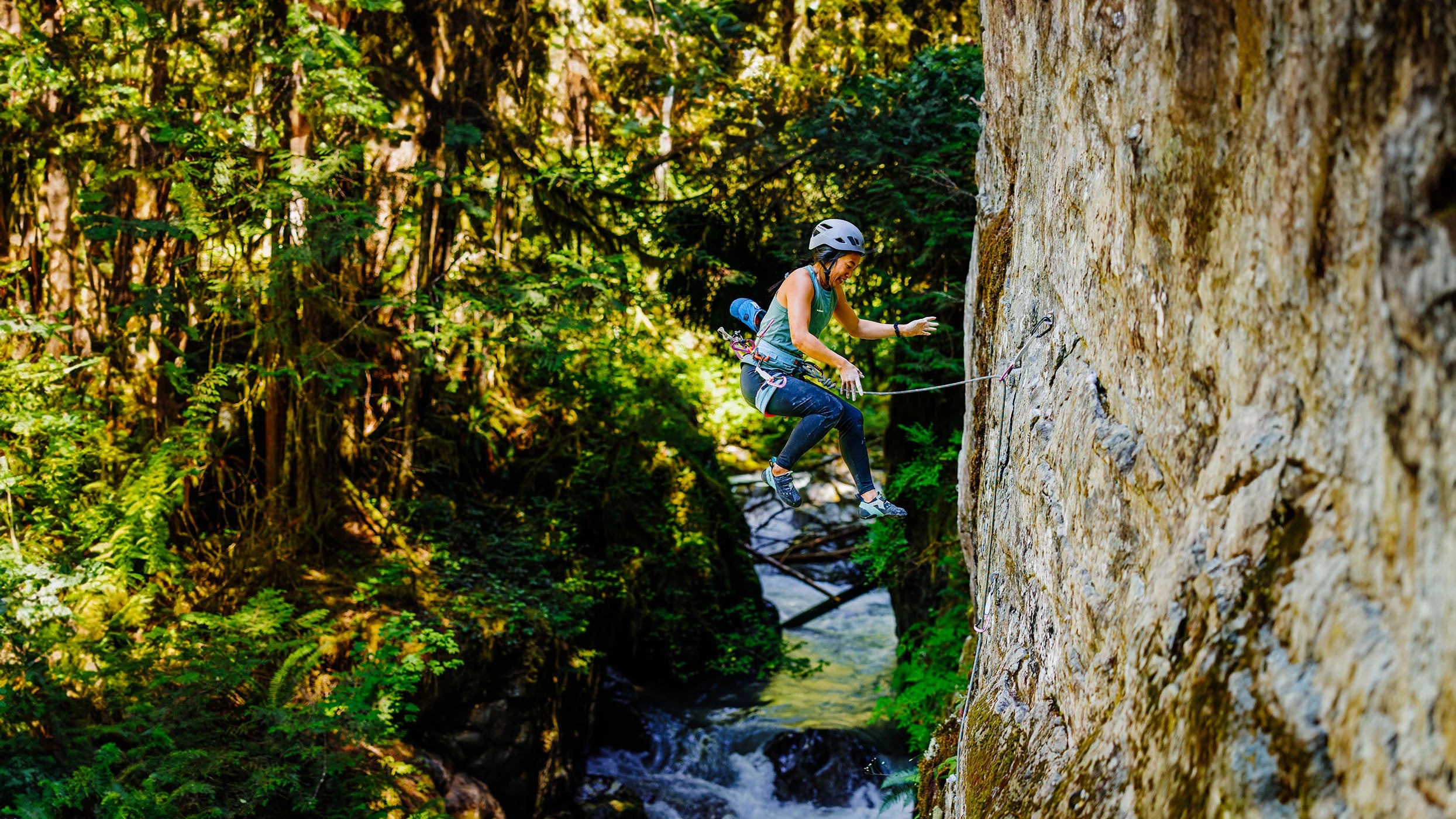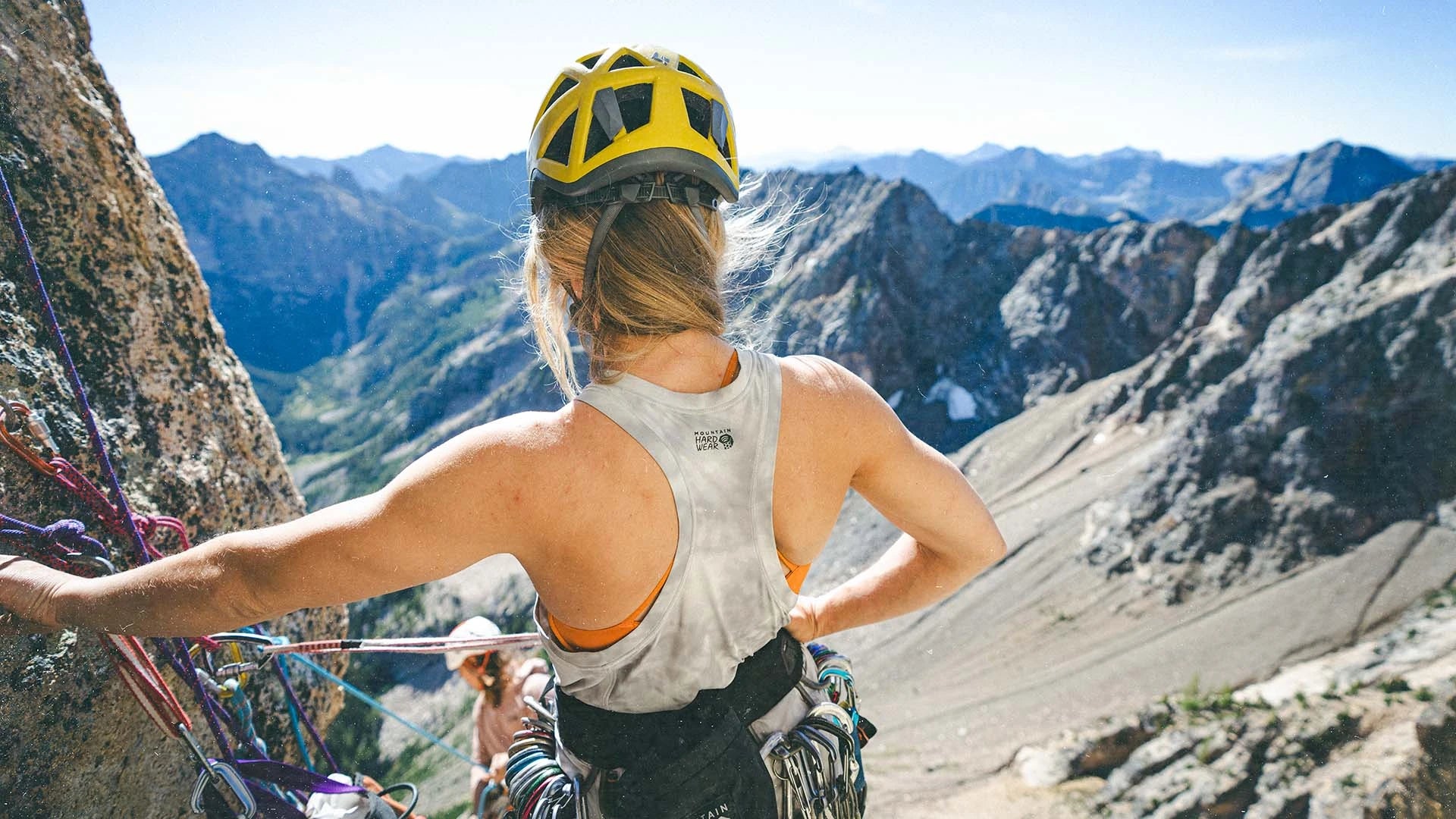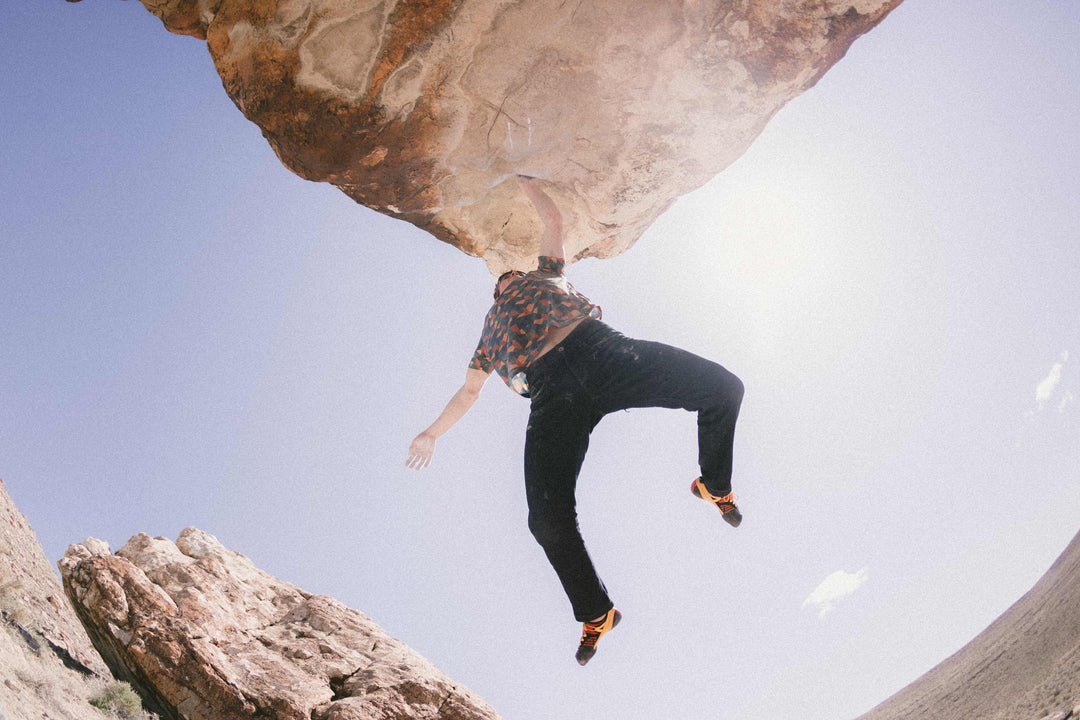Carabiners come in a variety of shapes and sizes, are designed for different purposes and have become very specialized over recent years. This guide is designed to help the reader understand which carabiner is best suited to which application and to help them make an informed purchase. The following is a breakdown of the different aspects you should consider when buying a carabiner.
Table of Contents

Above: Carabiner Breakdown
Types of Carabiners
Which carabiners are right for you? The answer to this question starts with finding out how the climber intends to use the carabiner, knowing its intended use greatly narrows the options.
Accessory Carabiners
Not rated for climbing, useful for dog leashes, organizing kids stuff and often found on water bottles.
Racking Carabiners
Lightweight and easily clippable for holding your cams, shoes and accessories to your harness. Racking carabiners are colour coded for easy selection of the correct cam size.
Rope Carabiners
Designed to be easily clipped with a single strand of rope; these smaller carabiners are often used at the bottom end of a quickdraw.
Bolt Carabiners
Designed to be clipped to a bolt either at the top of a quickdraw, your personal anchor system or as part of your anchor kit.
Belay Carabiners
Designed to have one or more strands of rope running in them. These carabiners will be large enough to accommodate a munter hitch or two strands of rope while rappelling. Wider aluminum stock provides additional control when catching a fall or lowering a climber.
Master Point Carabiners
Designed to be used as a focal point on the anchor, these extra large carabiners will accommodate at least 4 other carabiners clipped to them.
Shape
Oval
Oval carabiners are where it all started, ideal for aid climbing or racking your nuts.They are affordable and versatile but not as strong as D-shaped carabiners. Oval 'biners have identical tops and bottoms and limit load shifting.
Pear/HMS
Belay or HMS (aka HalbMastwurfSicherung) carabiners, are designed to accommodate the rope or a munter hitch for belaying. This shape allows for a large gate opening, reduces twisting and is ideal for rappelling or for running the rope through when building an anchor.
Asymmetric D-Shape
Asymmetric D-Shape is sometimes referred to as modified D's but one end is smaller than the other to reduce weight and also give a larger gate opening than the regular D-Shape. This is probably the most popular carabiner shape today.
D-Shape
The strongest carabiner shape, as it holds the rope inline with the major axis. Both ends are symmetrical.

Above: Carabiner Shapes - Oval, Pear/HMS, Asymmetric D-Shape, D-Shape
Size
The size of a carabiner is defined by the length of its major axis, the amount the gate opens and the amount of rope it can accommodate in its basket.
Micro Carabiners
Example: Metolius FS Mini II Carabiner. These weight saving, full strength micro carabiners are best suited for arranging and organizing your equipment. They connect to accessories such as shoes, prusik cords or a knife on your harness.
Standard Carabiners
Example: Petzl Spirit Straight Gate Carabiner. These standard carabiners are suitable for clipping bolts and are often used on quickdraws.
Large Carabiners
Example: Metolius Element Keylock Carabiner. Large carabiners are ideal for accommodating a munter hitch or more than one strand of rope.
Extra Large Carabiners
Example: Petzl William Screw-Lock Carabiner. Extra Large carabiners are used as master points or in rescue when they accommodate multiple other attachments.

Above: Carabiner Sizes - Micro, Standard, Large, Extra Large
Gate Type
Non-locking Gates
- Straight Gate - Durable and easy to use, they clip onto bolts very easily.
- Bent Gate - A slight bend or curve in the gate makes clipping the rope very easy.
- Wire Gate - Lighter than both straight or bent gates, these are ideal in the cold and alleviate gate flutter during a fall.
Locking Gates
- Screw Gate - Example: CAMP Nimbus Lock Screwgate Carabiner. The gate has a screw mechanism which closes over the opening; it is not auto-locking.
- Twist Lock Gate - Example: Petzl Am'D Twist-Lock Carabiner. The gate has a mechanism which auto-locks and requires a twisting motion combined with a push motion to open.
- Ball Lock Gate - Example: Petzl Am'D Ball-Lock Carabiner. The gate has a mechanism which requires you to push in a ball and spin to open or close. This can be both auto-locking or require the climber to lock it.
- Magnetic Locking Gate - Example: RockLock Magnetron Carabiner. Incorporates magnets into the auto-locking feature, requires the climber to squeeze both magnets by pitching to open the gate.
- Slide Lock Gate - Example: Edelrid Pure Slider. Slightly more secure than a non-locking carabiner, the gate has a small sliding bar built in that needs to be slid down to open.
- Twin Gates - Example: Grivel Clepsydra L K10G Twin Gate Carabiner. A very creative way to ensure a carabiner remains closed, two gates requiring a very specific motion is the only way to open this.
- Auto-locking Gates - The mechanism on these carabiners will lock when the climber releases their grip. To open auto-locking carabiners may take two or three separate hand motions, often referred to as double or triple action. The greater the number of motions required to open, the lower the chance the carabiner will accidentally open. For example if you are roping up to cross a glacier and connect with a single carabiner, a triple action auto-locking carabiner with a captive eye is recommended.

Above: Carabiner Locking Gates - Screwgate and Auto-Lockers
Nose Type
The standard design of most carabiner noses incorporates a hook which the gate catches onto when closed. This hook greatly increases the strength of the carabiner but is notorious for also catching other things, like your rope when trying to take it out. An example of a Hook Nose carabiner is the Black Diamond MiniWire Carabiner.
There are quite a few variations to solving this problem.
- Hood Wire Nose - Example: CAMP Dyon Carabiner
- Key Lock Nose - Example: DMM Chimera Carabiner

Above: Carabiner Nose Types
Gate Opening Size
This gap is measured from the inside of the nose to the closest part of the gate when fully open. A larger carabiner will often have a large opening to accommodate multiple rope strands, a cable or other hardware. The clearance is provided in millimeters.
Carabiners with smaller gate openings may trap your finger when clipping, especially if you are wearing gloves or have larger hands. Carabiners with a larger gate opening will be difficult to squeeze/pinch, making it difficult to clip in a rope. A carabiner that suits your hand size will feel easy to clip, will accommodate the object you are clipping and won't trap your finger.
Stock Type
The cross section of a carabiner frame will greatly determine its weight, strength, cost to manufacture and change how a rope handles while running over it. Manufacturers have gone to great lengths to "cut out" material to reduce weight while maintaining strength, this has led to a huge variety in the look of carabiner frames.
Round
Made from smooth round aluminum, these are ideal for smooth rope handling. They are usually heavier, have a stronger strength rating and reduce friction. A larger diameter stock is typically used for carabiners designed for belaying, which will give greater braking power and control when lowering a climber or rappelling.
I-Beam
This highly modified flat shape will have a large amount of material cut out which creates a super light carabiner frame. The weight savings reduces the overall strength and costs more to manufacture. Material is usually left in place on rope bearing surfaces for better control and durability where the ropes run.
Hybrid
A mixture of a round stock and I-beam, used to reduce friction in some areas of the carabiner and save weight in others. These hybrids benefit from weight reduction while still reducing the friction and still maintain a high strength rating.

Above: Carabiner Stock Type - Round, I-Beam, Hybrid
Weight
The weight of a carabiner can be reduced by using lighter materials, reducing the size of the carabiner, removing material where not necessary or minimising the gate weight and closure mechanism. An extra large steel carabiner with a solid locking triple action gate made from round stock could weigh as much as 267g (Example: Singing Rock D Steel Carabiner - 50kN Triple-Lock) At the other end of the weight spectrum are extra small aluminum carabiners with wire gates that have been engineered to maximise material removed while still meeting minimum standards, these can weigh as little as 22g (Example: CAMP Nano 22 Carabiner - 22kN).
⚠ Generally, when selecting your carabiner it is important to note that as weight reduces, the overall strength, durability and size also reduces. So, while it might make sense to have super lightweight alpine draws that see very little loading and use, your belay carabiner will have to endure more abuse, rope wear and often hold two strands of rope.
Strength
Carabiner manufacturers wishing to use the CE and/or UIAA icons; etched into the spine of the carabiner, have to meet standards set out by the UIAA and obtain CE certification. (If you want to read about the UIAA standards they can be found on: UIAA Safety Standards). This means they are strong enough for climbing and thus takes the guesswork away from the buying process. Someone with a much greater understanding and ability to test gear is ensuring the carabiner you buy is fit for purpose. Always check to ensure the carabiner is certified.

Above: Carabiner certifications are usually etched at the spine of a carabiner.
The spine of a carabiner will contain a series of icons and numbers.
These icons represent the minimum breaking strength of the carabiner in three different configurations:
- Major Axis - Their strongest orientation, intended use.
- Minor Axis - Cross loaded, not recommended but may occur.
- Gate Open - Reduced strength when the gate is open; dangerous but may occur.
Most carabiners are certified for a minimum of 20kN, about 2 tons, along their major axis, which is more than strong enough if used correctly. However, carabiners can be broken by misuse or unintentional mistakes. ⚠ Be aware of:
- Carabiner noses catching on bolt hangers or other objects so they don't close. A fall on a hooked carabiner could result in a failure.
- Cross loaded carabiners. Sometimes a carabiner will rotate as you climb by, a very hard fall with a heavy load can result in carabiner failure.
- Heavily worn carabiners can have sharp edges and cut your rope. While the carabiner itself might not fail quickly from wear it certainly can damage a rope running quickly over it.
Note: Carabiner strength differences above 20kN is not a factor recreational climbers should be concerned with as they are all "strong enough". The higher safety factors required for industrial purposes e.g (5:1) means manufacturers make carabiners rated up to 50 kN or more, these high kN rated carabiners are usually significantly heavier making them unsuitable for recreational climbing.
Extra Features
In an effort to improve carabiners manufacturers are forever experimenting with different technologies.
- Cross Loading Prevention Devices - Example: DMM Ceros Screwgate. Sometimes referred to as a captive eye, carabiners with this feature lock the belay loop or load into the major axis orientation to prevent cross loading.
- Incorporated Pulleys - Example: Edelrid Axiom. Combining a pulley and a carabiner gives climbers two tools in one. Useful in rescue and rigging scenarios where reducing friction is vital.
- Incorporated Rigging Plates - Example: Grivel Vlad Twin Gate Carabiner. Combining a rigging plate and a carabiner gives climbers two tools in one. Useful in rescue and rigging scenarios when multiple loads are attached to a single point.
- Steel Inserts - Example: Edelrid HMS Bulletproof Screw FG Carabiner. Carabiners are made from relatively soft aluminum which the rope wears down, by adding a steel insert the life of a carabiner can be greatly improved.
- Friction Spur - Example: Petzl Freino Carabiner - Auto-Locking With Friction Spur. Adding an extra loop or a friction spur the rope can easily be redirected to add friction when required.

Above: Carabiner Extra Features
Carabiner Manufacturing
Carabiners are generally made from 7075* aluminium, which gives a great balance between weight, strength and durability. The two basic ways of manufacturing carabiners from aluminum are.
- Cold Forging - The round stock/bar aluminum is bent into the required shape and stamped in a die at room temperature.
- Hot Forging - The aluminium stock/bar and forge dies are heated before stamping, which typically allows a manufacturer to create a lighter product with a more intricate design.
After the shape has been created the standard process is:
- Tumbling in ceramic chips to smooth out the edges.
- Drilling holes for the attachments (Gates or hinges).
- Anodizing to protect the aluminum.
- Assembly of the components.
- Inspection for quality control.
*7075 aluminium alloy's composition roughly includes 5.6-6.1% zinc, 2.1-2.5% magnesium, 1.2-1.6% copper, and less than a half percent of silicon, iron, manganese, titanium, chromium, and other metals.
Environmental Considerations
Over the past few years manufactures have started to address the environmental impact of carabiner production in a variety of ways. When investing in a rack of new carabiners your ecological footprint can be reduced through your purchasing decisions.
Longevity of the Equipment
Carabiners that need replacing quickly will end up in the landfill costing you more money to replace and increasing your environmental impact. Carabiners such as Edelrid Bulletproof series have steel inserts that slow the wear on the basket carabiner compared to softer aluminum.
Anodising
Anodising is an electrolytic process for producing thick oxide coatings, usually on aluminium. The oxide layer is typically 5 to 30µm in thickness and is used to give improved surface resistance to wear and corrosion, or as a decorative layer. This process however has an environmental impact from two byproducts, the water-waste, the anodization energy required and the disposal of the sludge produced. It is possible to buy non-anodized carabiners which avoid this process and therefore its impact, such as the HMS Bulletproof ECO.
Energy Offset
Energy offsetting whereby the manufacturer reduces their overall footprint by using alternative energy sources.
Bluesign Certification
Blue Sign Certification - 65 to 85% of the environmental impact of a product happens at the materials stage (Supply Chain). Looking at the whole supply chain and reducing the total impact allows manufacturers to achieve the Blue Sign Certification. Look for this certification when buying your next product.
Conclusion
Carabiners come in all shapes and sizes. Hopefully the information in this article helps to point you in the right direction, whether that is for racking your trad rack, building an anchor, selecting your first set of sport draws or climbing in the alpine or glaciated terrain. If you still have questions, please don't hesitate to contact us at Climb On. We love discussing gear and can help you make an informed decision to improve your experience on the climb.














Leave a comment